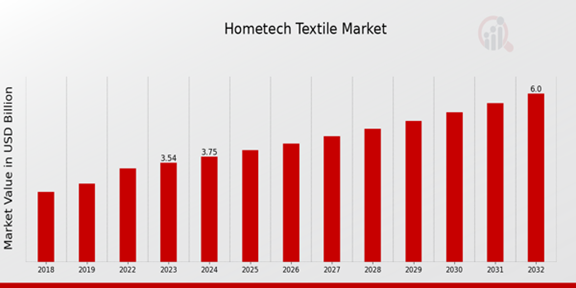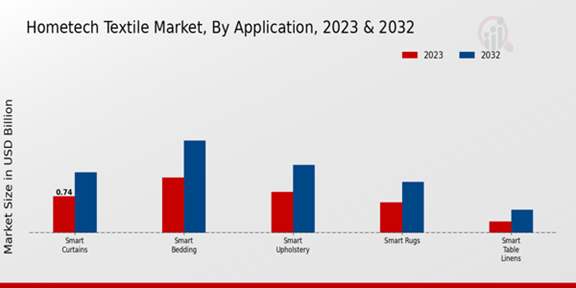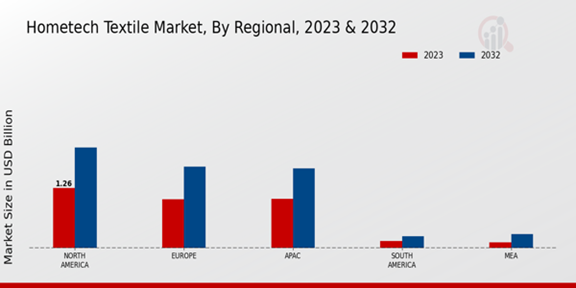Global Hometech Textile Market Overview
The HomeTech Textile Market Size was estimated at 3.98 (USD Billion) in 2024. The HomeTech Textile Industry is expected to grow from 4.22 (USD Billion) in 2025 to 7.16 (USD Billion) by 2034. The HomeTech Textile Market CAGR (growth rate) is expected to be around 6.0% during the forecast period (2025 - 2034).
Key HomeTech Textile Market Trends Highlighted
The home tech textile market is influenced by several key market drivers that shape its growth trajectory. Increasing consumer awareness about sustainable living has led to a surge in demand for eco-friendly textiles. Innovations in technology are also pushing the development of smart fabrics that enhance convenience and comfort in daily life. Furthermore, the growing trend of home automation has encouraged manufacturers to integrate textiles with smart technology, creating products that cater to the modern consumer's lifestyle. The rise of online shopping has made these products more accessible, allowing customers to explore diverse options quickly and easily.There are numerous opportunities to be explored in the home tech textile market. As consumers continue to prioritize comfort and sustainability, brands can focus on developing innovative products that meet these demands. The intersection of health and wellness with home textiles also presents an avenue for growth as products that promote better indoor environments gain popularity. Additionally, expanding to emerging markets can open up new customer bases and drive revenue. Collaborations with technology companies to create advanced smart textiles could serve as a competitive advantage, elevating brand recognition and market presence.Recent trends indicate a significant shift towards multifunctional textiles in home settings. Consumers are now looking for products that serve multiple purposes, such as upholstery that is not only aesthetically pleasing but also resistant to stains or easy to clean. There is a growing interest in textiles that incorporate temperature regulation, enhancing comfort year-round. The COVID-19 pandemic has further accelerated the trend of home-centric lifestyles, leading to increased investment in home technology. With the rise of telecommuting, there is a greater emphasis on creating comfortable and functional home environments. Overall, the dynamics of the home tech textile market indicate a promising horizon filled with potential for innovation and growth.

Source: Primary Research, Secondary Research, MRFR Database and Analyst Review
HomeTech Textile Market Drivers
Growing Demand for Smart Home Solutions
The HomeTech Textile Market Industry is experiencing significant growth driven by the increasing demand for smart home solutions. As consumers become more interested in convenience and efficiency, there is a noticeable shift towards integrating technology into everyday household items. Smart textiles that offer functionalities such as temperature regulation, moisture-wicking, and other interactive features are gaining popularity. This trend is further fueled by advancements in home automation technologies, where textiles are designed to work seamlessly with smart home devices.Consumers are not only looking for aesthetics but also for textiles that bring added value to their homes. The ability of home textiles to communicate with home automation systems enhances the overall user experience, leading to a sustained increase in market interest and investment. Additionally, as people become more environmentally conscious, textiles that offer sustainable technologies and energy-efficient properties are becoming highly sought after.This shift in consumer preferences also promotes the development of more innovative and technologically advanced textiles, solidifying the driving force behind the market's expansion.
Technological Advancements in Textile Manufacturing
Technological advancements in textile manufacturing play a crucial role in the HomeTech Textile Market Industry's growth. Innovations such as 3D printing, automated weaving, and smart fabric development have revolutionized how home textiles are produced. These advancements allow manufacturers to create fabrics that are not only functional but also stylish and comfortable, catering to diverse consumer needs. Moreover, the integration of Internet of Things (IoT) technology into textiles allows for the production of smart fabrics that can monitor and respond to environmental conditions, which enhances their appeal in modern homes.This technological evolution helps manufacturers reduce production costs and increase efficiency, which in turn benefits consumers through competitive pricing and improved product quality.
Increasing Awareness of Health and Wellness
The growing awareness of health and wellness among consumers is significantly driving the HomeTech Textile Market Industry. There is an increasing trend towards using textiles that contribute positively to health, such as hypoallergenic, antimicrobial, and breathable materials. This trend aligns with consumer preferences for healthier living environments, especially in home settings. As people become more informed about the impacts of their surroundings on their well-being, the demand for home textiles that promote health benefits is expected to increase.This shift not only shapes purchasing decisions but also encourages manufacturers to innovate and develop products that meet these health-oriented demands.
HomeTech Textile Market Segment Insights
HomeTech Textile Market Application Insights
In the HomeTech Textile Market, the Application segment plays a pivotal role in shaping the industry landscape, with significant contributions from various innovative sub-categories. In 2023, the overall market was valued at 3.54 USD Billion, showcasing a growing interest in technology-integrated textiles for home use. The Smart Curtains segment holds a valuation of 0.74 USD Billion in 2023 and is expected to reach 1.23 USD Billion by 2032, indicating its importance in enhancing energy efficiency and privacy control in modern homes. Another vital contributor is the Smart Bedding segment, valued at 1.12 USD Billion in 2023, which is projected to grow to 1.88 USD Billion by 2032; this segment addresses the rising consumer demand for comfort and wellness, highlighting its significant role in the overall market.Smart Upholstery, valued at 0.83 USD Billion in 2023, aims to transform the furniture sector through advanced materials that offer stain resistance, durability, and easy maintenance, which appeals to homeowners looking for practical and stylish solutions. Smart Rugs, with a valuation of 0.62 USD Billion in 2023, is gaining momentum as more consumers embrace multifunctional designs that include features such as heating and smart connectivity, further diversifying the market offerings. Lastly, Smart Table Linens, though valued at 0.23 USD Billion in 2023, shows promise for innovation in dining experiences, making it a noteworthy area for growth.Overall, the HomeTech Textile Market segmentation demonstrates that the Application segment comprises essential innovations that cater to modern consumer needs, driving growth and investment opportunities within the industry.

Source: Primary Research, Secondary Research, MRFR Database and Analyst Review
HomeTech Textile Market Material Type Insights
The HomeTech Textile Market, with a valuation reaching 3.54 billion USD in 2023, encompasses a diverse range of material types, each playing a vital role in the industry's dynamics. Cotton, known for its softness and breathability, remains a popular choice among consumers, while polyester is favored for its durability and resistance to wrinkles, making it a substantial part of the market's segmentation. Nylon, recognized for its strength and elasticity, holds a significant place, especially in products that require enhanced performance. Wool offers natural insulation, making it a preferred choice for high-quality home textiles, while blended fabrics gain traction due to their ability to combine the benefits of different materials, leading to versatility and functionality.The evolving consumer preferences, coupled with the rise in smart textile innovations, drive the market growth within these segments. Moreover, sustainability is becoming a crucial factor, with a growing demand for eco-friendly materials influencing market strategies and production practices.
HomeTech Textile Market End Use Insights
The HomeTech Textile Market, valued at 3.54 USD Billion in 2023, showcases a diverse range of opportunities across the End Use segment. This segment encompasses various applications, including Residential, Commercial, and Institutional environments, which collectively drive substantial market growth. The Residential subsector stands out as a significant contributor to the market, influenced by rising consumer demand for smart textiles that enhance comfort and convenience at home. In the Commercial space, the integration of tech-driven textiles in office settings fosters increased productivity and aesthetic value.The Institutional sector, catering to educational and healthcare facilities, plays a crucial role by focusing on durability and functionality, ensuring safety and efficiency in operations. The total market is expected to grow notably, with a projected increase in consumption due to advancements in textile technology and an increasing emphasis on energy efficiency. Overall, the diversification within the HomeTech Textile Market segmentation presents robust opportunities as trends continue to evolve, fostering innovation and investment in each identified End Use category.
HomeTech Textile Market Functionality Insights
The Functionality segment of the HomeTech Textile Market is evolving, with an overall market value of 3.54 USD Billion in 2023. This segment encompasses various applications, notably including Temperature Control, Light Control, Sound Absorption, and Air Quality Improvement, each contributing uniquely to the market landscape. For instance, Temperature Control textiles are vital for enhancing comfort in homes, allowing consumers to maintain ideal indoor climates while being energy efficient. Light Control solutions not only assist in managing natural light but also play a crucial role in energy conservation, making them significant in contemporary living spaces.Meanwhile, Sound Absorption textiles are increasingly important in urban areas, providing essential noise reduction, enhancing privacy, and creating serene home environments. Furthermore, textiles designed for Air Quality Improvement are gaining traction, addressing health concerns related to indoor air pollution. Overall, the market is experiencing steady growth, driven by increasing consumer awareness regarding comfort, energy efficiency, and health, leading to a robust demand for innovative functionalities in home textiles. The HomeTech Textile Market revenue reflects these trends, showcasing a clear preference for functional textiles that enhance both living experiences and environmental sustainability.
HomeTech Textile Market Regional Insights
The HomeTech Textile Market revenue is projected to show significant growth across various regions, with North America holding the majority share valued at 1.26 USD Billion in 2023 and expected to grow to 2.1 USD Billion by 2032. Europe follows closely with a valued market of 1.02 USD Billion in 2023, expanding to 1.7 USD Billion in 2032, reflecting a growing interest in smart textile technologies. The APAC region is another significant market, valued at 1.03 USD Billion in 2023, with an expected rise to 1.66 USD Billion in 2032, driven by increasing consumer electronics adoption and technological advancements.South America and MEA represent smaller segments, with valuations of 0.15 USD Billion and 0.12 USD Billion, respectively, in 2023 and expected to reach 0.25 USD Billion and 0.29 USD Billion by 2032. The market dynamics are influenced by growing awareness of smart homes and energy-efficient solutions, providing opportunities for innovation in textile technologies. However, challenges such as high costs and competition from traditional textiles may impact market growth. Overall, the HomeTech Textile Market segmentation highlights a strong growth potential, particularly in North America and Europe, reflecting a robust trend towards the integration of technology in household textiles.

Source: Primary Research, Secondary Research, MRFR Database and Analyst Review
HomeTech Textile Market Key Players and Competitive Insights
The HomeTech Textile Market is experiencing robust growth due to rising consumer demand for innovative and functional home textile solutions that enhance comfort and convenience. This market is characterized by a diverse range of products, including smart curtains, sensor-equipped bed linens, and climate-controlled fabrics that provide enhanced living experiences. Competitive dynamics are shaped by advancements in technology, increased sustainability awareness among consumers, and the integration of artificial intelligence into textiles. The convergence of home automation and textile functionality is paving the way for tailored products that cater to the increasingly sophisticated expectations of consumers. Companies are continuously innovating and developing unique offerings while navigating regulatory landscapes and supply chain challenges, which adds to the complexity of competition in this evolving market space.Honeywell stands out in the HomeTech Textile Market with its substantial investment in smart textile technologies that fuse function with comfort. The company leverages its extensive expertise in automation and control systems to enhance the performance attributes of home textiles. Innovations such as temperature-regulating fabrics and smart sensors demonstrate Honeywell's commitment to improving consumer living conditions through technology. The brand's focus on sustainability further bolsters its market presence as it develops eco-friendly textile solutions that resonate with today's environmentally conscious consumers. This alignment with market trends reinforces Honeywell’s strength in delivering cutting-edge products that not only meet functional needs but also incorporate a sense of style and modernity into home environments.Sharp, recognized for its innovation and commitment to quality in the HomeTech Textile Market, has made significant strides in integrating technology into the textile industry. The company emphasizes the development of textiles that incorporate air purification and moisture control features, catering to the growing demand for health-conscious home products. Sharp's advancements in nanotechnology for textiles serve as a unique selling point, setting the brand apart in a crowded marketplace. By focusing on the functionality and performance of its textiles, Sharp appeals to consumers looking for products that enhance their home environment not only through aesthetic appeal but also through tangible benefits to health and well-being. These strengths contribute to Sharp's competitive position, allowing it to consolidate its presence within the home tech textile sector.
Key Companies in the HomeTech Textile Market Include
- Honeywell
- Sharp
- Dometic
- GE Appliances
- Whirlpool
- Bosch
- Philips
- Siemens
- Midea
- Electrolux
- TCL
- LG Electronics
- Panasonic
- Daikin
- Samsung
HomeTech Textile Market Industry Developments
The HomeTech Textile Market has recently seen a surge in developments as major players continue to innovate and expand their offerings. Companies like Honeywell, Whirlpool, and LG Electronics are focusing on sustainable textiles, driving interest in eco-friendly home technologies. Additionally, mergers and acquisitions remain a prominent theme; Midea recently acquired a smaller textile company to enhance its product portfolio, aligning with industry trends, while Bosch and Siemens continue to collaborate on smart textile applications that integrate seamlessly into home automation. The valuation of companies such as GE Appliances and Philips is on the rise, indicating strong market growth, particularly driven by advancements in smart textiles and connected home solutions. Dometic and Electrolux have also reported increases in sales driven by consumer interest in high-tech textile products that offer improved comfort and convenience. Meanwhile, Samsung and Panasonic are launching innovative smart textiles that provide enhanced functionality, reflecting the market's shift towards technology integration in home textiles. This trajectory illustrates the growing intersection of home technology and textile innovation, marking a transformative phase for the industry.
HomeTech Textile Market Segmentation Insights
HomeTech Textile Market Application Outlook
- Smart Curtains
- Smart Bedding
- Smart Upholstery
- Smart Rugs
- Smart Table Linens
HomeTech Textile Market Material Type Outlook
- Cotton
- Polyester
- Nylon
- Wool
- Blended Fabrics
HomeTech Textile Market End Use Outlook
- Residential
- Commercial
- Institutional
HomeTech Textile Market Functionality Outlook
- Temperature Control
- Light Control
- Sound Absorption
- Air Quality Improvement
HomeTech Textile Market Regional Outlook
- North America
- Europe
- South America
- Asia Pacific
- Middle East and Africa
| Report Attribute/Metric |
Details |
| Market Size 2024 |
3.98 (USD Billion) |
| Market Size 2025 |
4.22 (USD Billion) |
| Market Size 2034 |
7.16 (USD Billion) |
| Compound Annual Growth Rate (CAGR) |
6.0% (2025 - 2034) |
| Report Coverage |
Revenue Forecast, Competitive Landscape, Growth Factors, and Trends |
| Base Year |
2024 |
| Market Forecast Period |
2025 - 2034 |
| Historical Data |
2020 - 2024 |
| Market Forecast Units |
USD Billion |
| Key Companies Profiled |
Honeywell, Sharp, Dometic, GE Appliances, Whirlpool, Bosch, Philips, Siemens, Midea, Electrolux, TCL, LG Electronics, Panasonic, Daikin, Samsung |
| Segments Covered |
Application, Material Type, End Use, Functionality, Regional |
| Key Market Opportunities |
Smart fabrics integration, Eco-friendly textile solutions, Increased home automation adoption, Customizable textile designs, Enhanced durability and performance. |
| Key Market Dynamics |
Technological advancements, Rising consumer demand, Sustainable materials adoption, Increasing disposable income, Smart home integration |
| Countries Covered |
North America, Europe, APAC, South America, MEA |
Frequently Asked Questions (FAQ) :
The market is projected to be valued at 7.16 USD Billion in 2034.
The expected CAGR for the market is 6.0% during the forecast period.
North America is expected to have the largest market share, valued at 2.1 USD Billion in 2034.
Smart Curtains are projected to be valued at 1.23 USD Billion in 2034.
Major players include Honeywell, Sharp, Dometic, GE Appliances, and Whirlpool.
The market is valued at 3.98 USD Billion in 2024.
Smart Bedding is expected to reach a market size of 1.88 USD Billion in 2034.
Smart Rugs are projected to be valued at 1.04 USD Billion in 2034.
Europe is projected to be valued at 1.7 USD Billion in 2034.
Smart Upholstery is valued at 0.83 USD Billion in 2024.

















